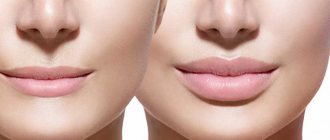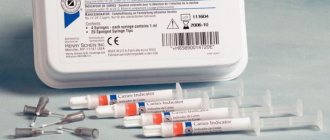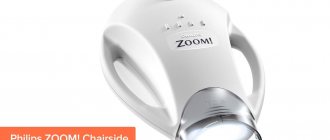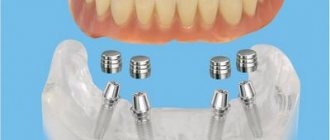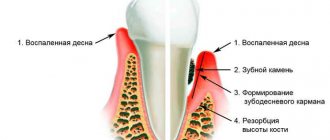How to choose a boxing mouthguard for teeth
A boxing mouthguard is a soft overlay for teeth that is used by athletes during sparring and combat training.
It is designed to protect teeth and lips from possible injuries, among which the most common are lacerations in the mouth, damage and bruises to the cheeks and lips.
In addition, if a tooth is knocked out, it prevents it from entering the trachea.
- One-sided - placed on the upper jaw. The main advantage of this type of mouthguard is that it does not impede breathing during training.
- Double-sided - worn on the upper and lower jaws. It better protects the athlete’s teeth, but makes breathing significantly more difficult, since a small hole remains between the jaws.
The choice of a mouthguard for boxing directly depends on the purpose of its intended use. For training fights, you can choose a one-sided model, but if we are talking about professional sparring with a strong opponent in the ring, then it is better to give preference to a double-sided mouthguard.
Before purchasing such a dental protection product, you should decide on the type. Single-sided and double-sided models can be:
- Standard.
- Thermoplastic.
- Individual.
Athletes give particular preference to thermoplastic mouth guards, as they are versatile, comfortable and of high quality.
What types of mouth guards are there?
Since this dental accessory is used not only in boxing, you can find mouth guards for different sports on sale. Therefore, before purchasing, you need to make sure of the intended purpose of the product. Conventionally, protection for teeth can be divided according to several criteria.
By purpose
According to the purpose of the mouthguards there are:
- Designed to protect the teeth of the upper jaw.
- Designed for both jaws (equipped with a special hole through which the athlete can breathe).
By material
There are three types of boxing mouthguards for teeth:
- Hard standard (for those with perfectly straight teeth).
- Thermoplastic.
- Rigid, made according to an individual cast.
The best and most affordable material is thermoplastic. Thermoplastic aligners soften under the influence of hot water and then quickly cool, “remembering” the shape of the teeth. The main thing is to choose a product that is suitable in size.
By size and thickness
Choosing the size of a mouthguard to protect your teeth and mouth must be very careful. In Moscow you can buy mouth guards of different sizes and thicknesses. A product that is the right size can be perfectly adjusted to fit your teeth; a size that is too large will not allow the item to stay in the mouth, and an accessory that is too small will cause discomfort and pain in the teeth.
There are mouthguards for adults and children, in different colors and with different tastes. The most popular protective accessories are mint flavored.
As a natural antiseptic, mint provides additional protection against bacteria, and as a natural deodorant, it provides a feeling of freshness.
How to cook kapu
Buying a mouthguard is not everything. This protection product cannot be used immediately after purchase; it must be carefully prepared. The main thing is to cook the mouth guard correctly, strictly following all the instructions.
To carry out this simple procedure, you will need a kettle with water, two bowls - empty and with cold water, tongs or a slotted spoon.
- Boil one liter of water in a kettle and pour it into an empty bowl.
- Place the mouth guard in boiling water for 10-30 seconds. The instructions for use for the purchased protective equipment should indicate the optimal cooking time. If this item is missing, you should keep the mouthguard in a bowl of boiling water for 30 seconds.
- When the cooking time has expired, the mouthpiece should be removed from the bowl and placed in your mouth without waiting for it to cool. In this case, it is recommended to clench your teeth (the main thing is not to overdo it, so as not to bite through it), and with your fingers, press the mouth guard from the outside to your teeth so that it fits as tightly as possible. Thanks to this, the mouthguard is adjusted to the individual characteristics of the jaw and bite of the athlete.
- Fix this position of the mouth guard in your mouth for 3-4 minutes.
- Take it out and place it in a bowl of cold water. Keep it there until the cast is hardened.
How to properly prepare and cook a dental guard at home
Having realized the importance of the protective element and choosing a suitable copy from high-quality thermoplastic, all that remains is to prepare a mouthguard for boxing. After purchasing, you need to cook the burl, give it the desired shape and cool it. First you need to get rid of excess material at the edges by trying the mouthguard in your mouth and cutting off the excess, and then:
- Take a container (pan) of such volume that it is enough to freely place the product. Fill it with water.
- Place the container on the fire and wait for the liquid to boil.
- Using a tablespoon or slotted spoon, lower the mouth guard into boiling water and brew. When diving for the first time, you need to keep the product in water for no more than 30 seconds - this is the standard time during which thermoplastic softens. Some companies' products have special holders that can be used to immerse them in boiling water.
- Remove, wait until the temperature is tolerable: when the hot plastic becomes safe for the skin and mucous membranes.
- Insert the mouthguard into your mouth the way it should sit during the fight.
- Hold it tightly with both jaws, press with your tongue and hands, giving it an individual shape.
- Smooth out the outer free part of the material, leaning it against the gums, wait 15–20 seconds.
Less quality plastic requires longer exposure on the teeth - from 3 to 4 minutes. Characteristics are indicated in the instructions for use.
After unclenching the teeth, the product should remain on the upper jaw and sit quite tightly. Only in this case is it correctly fitted. But the preparation does not end there; it is completed by the most important stage - hardening. At home, cold water comes to the rescue. After pouring cooled boiled water into any container, you need to place the formed product in it and leave for 5-7 minutes or as long as necessary for hardening. During this time, the material will cool down and take the shape that will be most comfortable for the user.
Read also: How long does it take to cut the first teeth?
Note! In many videos where they cook mouth guards, the characters in the videos try to drown the plastic in boiling water, holding it with various cutlery. There is no need to do this. To make a mouthguard correctly, you need to let it “free float”. Even without complete immersion, the material will heat up perfectly and become plastic.
You can see the process of cooking and fitting the mouthguard in all details in the following video:
How the mouthguard should sit: checking and re-cooking
There are always doubts whether it was possible to correctly fit the protective element to the teeth and whether it will be comfortable for the boxer. To check, you will have to wait until the product cools down after cooking and put it on your teeth. Correct fit will ensure:
- comfort, absence of pain, rubbing;
- tight fit: if displacement is noticed when opening the mouth or turning the head, you will have to re-cook the mouth guard and adjust it again;
- exact correspondence of the shape of the accessory to the shape of the dentition and jaw features.
An external inspection will not be superfluous. Before putting on a mouthguard, you need to check for tooth marks. If they are clear and deep, then the protection is prepared correctly.
If you didn’t succeed in making a mouth guard to fit your teeth the first time, you can brew it again. This should be done using the same technology: prepare a container with boiling water and cook the plastic in it. To get the expected result after failure, it is worth reviewing the instructions for use again. You may need to increase the cooking time by leaving the product to cook for a longer period.
Check after cooking
Before wearing a mouthguard for training or combat, you should carefully check it to ensure it is ready and free of errors or defects.
The impression must contain dental imprints. This will ensure maximum retention of the guard so that no additional support from the lower jaw is required.
If mistakes were made during the preparation of the mouthguard, then as a result, the tooth marks will be invisible, and the protection will not adhere well to the teeth. Even with a weak finger press on it, you can notice a slight squeeze. In this case, the mouth guard cannot be used until the errors are corrected.
Good to know
Those who are just starting to train and are faced with the procedure for preparing a mouth guard for the first time should know a few important points.
- If the burl is cooked incorrectly, do not throw it away - the cooking procedure can be repeated.
- It is not advisable to purchase cheap mouth guards, as this can have a negative impact on your oral health.
- A properly prepared mouth guard should fit tightly. If it sits poorly, it means mistakes were made during the cooking process.
- It is recommended to change the mouthguard every season, since this means of protection tends to wear out over time, which leads to the loss of its protective functions.
- There is no need to try to drown it when placing it in a bowl of hot water - it should just float there.
- After each workout, rinse the mouthguard under running cold water, after brushing with a brush and toothpaste.
- A well-ventilated special container is required to store the mouth guard.
- Do not leave it in the sun - direct exposure to sunlight can lead to deformation.
- If the mouthguard is overcooked, then nothing can be done with it.
Boxing is a rather dangerous sport, as injuries are inevitable during training and competition. But an athlete should think first not about his career, but about his health. A correctly selected and properly prepared mouthguard will preserve the integrity of the teeth, tongue and soft tissues of the face.
Dental mouth guard: popular questions
Below are answers to the most common questions from patients who need orthodontic treatment and are planning to use a mouthguard to correct their bite.
Types of bites
It is not always possible to use mouthguards to treat a pathological bite. Contraindications for the use of such structures are:
- the presence of carious cavities and hard dental deposits (tartar) on the teeth;
- anomalies and defects of the dental system caused by deformation of the facial skeleton;
- inflammatory and other diseases of the temporomandibular joint;
- periodontitis (acute stage);
- the presence of impacted teeth (held by the gums or bone elements of the tooth);
- destroyed tooth roots.
Impacted tooth
Aligners should not be used on patients with severe disorders of the central nervous system, such as epilepsy.
At the patient’s personal request, the technologist can make a colored mouthguard. Some companies even produce aligners with decorative elements and various inscriptions, but classic transparent aligners remain the most popular.
Colored mouth guards
There are no significant differences between these materials that could affect the medicinal and practical properties. Both silicone and plastic aligners retain their shape perfectly, do not injure the mucous membranes, do not cause discomfort and adapt well to the tooth’s own tissues.
Photo of a mouthguard for teeth
Individual recommendations regarding the time of regular wearing are given by the doctor, taking into account the identified defects and the degree of deformation of the dentition. For mild misalignment, as well as for the treatment of bruxism, it is enough to wear the aligner while sleeping at night. In other cases, the recommended wearing period is 20-22 hours.
How to wear aligners
The mouth guard can be removed while brushing your teeth, eating, and in other exceptional cases (but for no more than 15-20 minutes at a time).
Transparent aligner
Product care
To maintain hygiene and care, the mouth guard must be cleaned regularly. This is done using ordinary running water or a soap solution (with the addition of laundry or tar soap). After this, the mouthguard should be cleaned in the same way as your own teeth, using toothpaste and a brush. It is better to choose a brush with soft bristles so that the product does not become deformed as a result of use.
Mouth guard care rules
A dental guard is an orthodontic device that is an excellent alternative to braces if the bite is slightly deformed, and it is possible to correct it without the use of orthodontic brackets. The mouthguard has excellent aesthetic properties, does not cause discomfort during use, and is practically unnoticed by others.
Another advantage of such devices is the high quality of oral hygiene during treatment, since the mouth guard is easy to remove and put back without the help of a dentist. The disadvantages of the product include the rather high cost (based on a full course) and a narrow range of applications - these are the only reasons why aligners have not yet become a universal method of bite correction and are not used as often as compared to classic brace systems.
How to cook kapu
A mouthguard is a special protective device that is inserted into the mouth. The mouthguard protects the athlete's jaws and teeth from damage. It is used in those sports where there is a high probability of damage to the oral cavity: boxing, hockey, American football and others. Mouthguards are sold in sports stores, but they are all standard. In order for the mouthguard to fit comfortably in the mouth, it must be adjusted to the structure of the jaw and teeth. There is even a term “cook kapa”, i.e. treat it with hot water so that it softens and takes the desired shape.
Read also: Teeth whitening with citric acid
- Boil water and pour it into a bowl.
- Place the mouthguard in hot water and keep it there for as many seconds as written in the instructions.
- Remove the mouthguard from the water and insert it into your mouth.
- Press the mouthguard with your teeth so that it fits comfortably in your mouth.
- Press the mouth guard against your teeth with your fingers so that the inside of the mouth guard fits as tightly as possible against your teeth.
- Keep the mouth guard in your mouth for three to four minutes.
- Carefully remove the mouth guard and place it in cold water to cool further.
- After 10 minutes, remove the mouthguard from the water.
Sometimes it happens that the packaging does not indicate how long the capu should be kept in boiling water. Then cook the mouth guard for no more than 30 seconds - this is the standard time for softening the thermoplastic mass.
- Wash with clean, cool water after each use;
- store in a special ventilated container;
- Do not expose to extreme heat or cold (sun or frost).
It is recommended to wear one mouth guard for no more than one sports season. Then you need to dispose of it and make yourself a new mouthguard. Protect your teeth and don't skimp on it. After all, due to carelessness or sudden movements, you can be left without them. In this case, a trip to the dentist will cost many times more than regularly purchasing and updating a mouth guard.
The combination of mountains and sea makes Crimea a wonderful place to relax. Having been here once, it is impossible to forget the majestic beauty of Crimea. An exploration of the peninsula should begin with an understanding of personal interests. If you like nature, look for bizarre mountains, caves, waterfalls and castle ruins. I like historical monuments – museums, palaces and fortresses are perfect. Here you will find attractions [...]
Lizun (handgam) is a popular jelly-like toy that feels like soft rubber. Children, and adults too, enjoy playing with it: stretching it, twisting it, tearing it apart and gluing it back together. And she appeared thanks to the cunning and gluttonous hero from the cartoon “Ghostbusters” - a green ghost whose name was Lizun. Does your child like this character too? Then do a handgam [...]
Not many representatives of the fair sex get a beautiful and elastic butt. However, almost all women dream of attractive shapes of their buttocks. You can get the desired result, but for this you need to make every effort. With the help of a set of exercises that we will talk about in this article, you will ensure that your buttocks acquire a chic look. 1 Set of exercises Even […]
Currently, it is considered fashionable to look fit, slim and young; appearance is becoming a second calling card, not to mention the fact that it is simply good for health. But not everyone manages to achieve this - a sedentary lifestyle, laziness, stress, the environment, various disorders (metabolism, hormonal, endocrine), diseases and poor nutrition make themselves felt. There is […]
Modern technologies have led to the fact that running shoes can optimize sports activities, train more and more productively, eliminating the risk of injury. The sneakers have a sole that provides cushioning and an upper that provides ventilation. People who run professionally know the importance of choosing the right shoes. If you know how to do this, you can save money and also get […]
Hockey is a very popular sport and you can hardly find a guy or man indifferent to this game. The most important piece of equipment for a hockey player is the stick; without it it is impossible to score the puck into the opponent’s goal. But novice athletes do not yet know how to choose a good stick so that it will bring good luck in the game. When purchasing, the material of the product is taken into account, [...]
Regular hoop training has a lot of positive effects. The first and most important effect is weight loss. Rotation of the hoop also models the figure in the most difficult areas - the abdomen, waist, hips. During hula hoop exercises, blood circulation improves and blood pressure returns to normal. Your spine will become more flexible, which will solve many back and lower back problems. Through […]
On the path to acquiring ideal forms, you encounter obstacles in the form of problem areas in the abdomen and sides. A rational healthy diet and an active lifestyle will help you reduce your volume and get a flat tummy. There are several recommendations on how to increase the effectiveness of proper nutrition and physical activity, and get a toned stomach and sides in a short time. 1 Eliminate fast food from your diet […]
Reasons for the development of pathology
Snoring is a rattling sound that occurs during deep sleep as a result of a disruption in breathing. The consequence of disturbances in the respiratory system is relaxation of the muscle structures of the pharynx and the back of the palate.
For this reason, the inhaled air flow moves through the upper breathing apparatus incorrectly, which causes a special sound.
Interesting to know! According to statistics, about 47% of men and 28% of women suffer from regular snoring.
Let's look at the common causes of snoring:
- Curvature of the nasal dividing plate.
One of the most common causes of snoring, which affects people of all ages. The plate dividing the nasal cavity into two equal halves is deformed under the influence of trauma. The resulting curvature becomes an obstacle to the normal passage of air flow. In addition, the violation provokes the development of chronic rhinitis, which further aggravates the problem. - Tonsillitis (damage to one or more tonsils). Hypertrophy of the palatine tonsils is an infectious disease caused by bacterial or viral infections. Inflammatory enlargement of the tonsils creates a barrier in the lumen of the nasopharynx. During difficult breathing, muscles vibrate and vibrating sounds appear.
- Polyposis of the initial part of the respiratory apparatus.
Polyps in the nasal cavity are benign, round-shaped formations. During the growth stages, they gradually block the nasal passages, making it difficult to breathe freely. The disease affects the adult category of patients. The problem is aggravated by the fact that it is quite difficult to recognize the disease in the early stages of development - polyps make themselves felt when their size causes not only snoring, but also nasal congestion. - Proliferation of lymphoid tissue (adenoid vegetations). The pathological condition leads to an enlargement of the pharyngeal tonsil and problems in respiratory functions. More often, adenoids are detected in children. The disease occurs due to the entry of an infectious agent into the body or due to allergic reactions. An increase in lymphoid tissue can be recognized by the appearance of very noisy breathing.
- Rhinitis (runny nose).
The disease is manifested by swelling, nasal congestion, the appearance of mucus and develops against the background of the proliferation of microbes or due to infection with a virus. In some cases, the disease occurs due to hypothermia. The most common cause of snoring is the catarrhal type of rhinitis. It can be recognized by the occurrence of swelling of the nasal mucosa, which narrows the lumen of the nasal passages, making breathing difficult. - Alcohol abuse, taking sleeping pills and psycholeptics. During night sleep, the muscles are in a state of relaxation. The muscular structures of the respiratory apparatus are no exception. Psychotropic drugs and alcohol-containing drinks further relax the organs formed by muscle tissue, which is why a person who is in the stage of alcoholic intoxication snores very loudly. The problem will disappear if you get rid of the bad habit.
- Deformation of the nasopharynx due to age-related changes. Over the years, muscle tone changes. In addition, a person may suffer from chronic infectious diseases of the upper respiratory tract. For this reason, when a person lies on his back and falls asleep, the muscles of the pharynx sag. This condition causes low-frequency vibrations of the velum and the lesser process (uvula).
- Overweight. In obese people, fatty structures in the neck area develop greatly. This leads to compression of the upper respiratory tract, which leads to oxygen starvation of the body. Over time, obese people develop obstructive sleep apnea syndrome, which is characterized by temporary cessation of breathing during the period of night rest.
- Congenital factor. A large tongue, elongated minor process or palate can cause snoring sounds.
In some cases, rhonchopathy develops for the following reasons:
- body fatigue;
- disturbance of emotional calm;
- drug intoxication;
- sleep on your back or stomach.
To understand why you need to wear mouthguards after removing braces, you need to know the basics of the anatomy of the maxillofacial apparatus. Many ignorant patients do not understand why this step cannot be avoided. After all, all the problems are behind us, those around us admire the attractive smile of the owner of straight and white teeth. And then, it turns out, everything can change again for the worse. So what is the reason?
It's all about the structural features of the teeth. The teeth are surrounded by a space in which the ligaments and vessels that hold them in the jaws are located. With the help of braces, the ligaments are stretched and the teeth move in the jaw in the right directions. This is associated with a feeling of pain in the area of the fixed teeth during the period of bite correction.
Stretched ligaments strive to return the teeth to their original position, but dental structures interfere with them. However, after removing the braces, nothing prevents the ligamentous apparatus of the teeth from taking their original positions. It is to inhibit this natural process that special devices or mouth guards are used.
We suggest you read: Pimple in the mouth on the gum above the tooth in an adult and a child: white, purulent
How to cook and put a mouthguard on your teeth
Human teeth consist of bone tissue, which is strong, hard and has a long wear life. Such fabric is capable of withstanding enormous loads, however, over time it wears out and weakens, and is damaged in the event of regular stress, bruises and impacts, which ultimately requires additional protection.
For this purpose, dentistry has come up with special onlays that can protect the enamel from damage, as well as straighten the teeth and even whiten them.
Read also: Tea tree oil for teeth
Design features and when to use it
In this article we will look at how to choose a mouthguard for teeth, what is necessary for its proper preparation and wearing.
In essence, a mouthguard is an orthodontic system for the dentition of the upper or lower jaw, as well as for both at once. It has several purposes, depending on the shape and type: protective, leveling, whitening and supporting.
As a rule, the structure is made of hypoallergenic and biologically compatible materials - silicone, plastic, gel-like composites. All components for the manufacture of a mouthguard must meet medical requirements, as well as quality indicators.
Where can you buy a similar design? Protective mouthguards are used to fix and protect the jaw from bruises , falls and impacts, which often occur in athletes. You should look for them in specialized sports stores. For the treatment of dental pathologies and defects (uneven teeth, yellow or gray enamel, etc.), structures are purchased in pharmacies or ordered from dentistry using an individual cast of the jaw.
Some options can be purchased in online stores, however, then you run the risk of purchasing a fake, low-quality product, or simply unsuitable for your jaw structure.
Let's consider for what specific cases a mouth guard is purchased.
- Grinding of teeth during sleep (bruxism) is an unpleasant ailment that leads to rapid wear of the dental bone, changes in bite, and damage to crowns and implants. In addition, this process is unpleasant for others. The pads help keep the jaw in the required position and prevent the enamel from touching.
- Professional athletes (especially in the field of boxing and martial arts) cannot do without mouthguards, as they regularly receive injuries to the jaw area. The product allows you to protect your teeth during a sharp closure of the jaw (fall, bruise), and also prevents them from being knocked out (impact).
- Special designs for whitening allow you to carefully lighten enamel at home, without resorting to abrasive pastes and mechanical cleaning. This option will be ideal for people with sensitive, demineralized or naturally thinned enamel.
Mouth guards allow you to straighten your teeth and even correct your bite
Purpose of a protective mouth guard
Every athlete sooner or later faces the question: “What material is better to buy a mouth guard from?”
- The most inexpensive are mouthguards made of latex or rubber. As a rule, cast plates are made from this material. Professional athletes do not use such mouthguards due to their inability to reliably protect against serious injuries.
- The average price option is plates made of silicone. They are boiled, and therefore are able to take into account the anatomical features of the athlete’s jaw. These mouthguards are used by mid-level fighters.
- Mouthguards for professional athletes are made from gel-like materials. This material allows you to accurately copy the shape of the athlete’s jaw, and during the fight it provides a high degree of protection.
It is also worth noting that a number of requirements are imposed on the mouth guards of professional fighters. If the plates used by the athlete are not able to provide the fighter with a certain level of protection, then the athlete is simply not allowed to compete.
It is necessary to wear a mouth guard for:
- Lip protection. Despite the fact that the product is designed to protect the dentition and jaw, its use also helps to protect the lips. It will not be possible to completely protect them from injury, but the number of lacerations will be significantly reduced.
- Exceptions for cerebral hemorrhage.
- Preventing damage to the trachea from dental fragments.
- Avoiding displacement of the cervical vertebrae.
- Reduce the likelihood of concussion.
Experienced boxers note that a mouthguard should also be used to relieve tension in the facial muscles. This helps to quickly restore balance after missed hits.
Children also need protection - you need to put a mouthguard on your child’s teeth both during training and before serious sparring. A novice athlete must know how to use a mouthguard and how it should fit. Only those parents whose children wear braces will need to seek professional help.
We suggest you read: What does a dental cyst look like in the picture?
How to choose a mouth guard
Many patients are interested in how to make a mouthguard and prepare it for constant wear. To bring it into a suitable form, first select the design itself, based on our advice.
So, sports models designed to protect the dentition from injuries, impacts and other mechanical damage should be chosen in stores for professional sports or tourism. Such designs are produced under well-known brands, which is a guarantee of quality. In addition, separate models are produced for various sports and wrestling.
Dental options can be purchased at a pharmacy or clinic, but it is still better to make an individual impression of the jaw.
To correct the bite and straighten teeth, exclusively individual mouth guards are used.
Once you have determined the scope of application, manufacturer and place of purchase, select the type and shape of the structure. You can choose from mouthguards for one jaw or both. As for the material of manufacture, choose a moderately rigid structure.
A mouth guard that is too elastic and soft will quickly deform and will not perform the expected functions, while a mouth guard that is too hard will cause discomfort when worn and may partially damage the thin layer of enamel.
Let's look at the most popular types of mouth guards today.
- Ready . Sold in supermarkets, pharmacies, as well as in sports departments, available for order on the Internet. They have an absolutely standard shape and size, so they are not suitable for some patients. The main advantages are reasonable price, available in mass sale. Disadvantages - not suitable for everyone, the design is massive, which interferes with normal communication and breathing while wearing.
- Thermoplastic . The most popular and effective option at the moment. They are often chosen by professional athletes for their plasticity, reliability, strength and the ability to be individually adjusted to any dentition. To do this, such models come with instructions on how to cook mouth guards at home. Pros: high-quality materials, customizability. Disadvantages: high price, need for preparation before use.
- Individual dental. Such structures are made in a special dental laboratory or at a dentist’s appointment.
The doctor takes measurements of the dentition and makes a plaster cast to record all the anatomical features of the patient’s jaw.
Positive aspects - extremely reliable design, comfort while wearing, dental functions (bite correction, teeth straightening, disease prevention, etc.). The disadvantage is the high price, production times range from 2 weeks to 1-2 months.
Teeth whitening tray
What types of mouth guards are there for boxing and martial arts?
We wrote a separate article about this, but we’ll tell you briefly again. Most of the blows in boxing are either to the upper body or to the head, and specifically to the eyes, nose, and especially often the teeth and jaw. With a very strong impact and without a mouth guard, the athlete’s teeth can begin to crumble, and the jaws can hit each other with such force that it is easy to get a concussion. Therefore, the most important function of a mouthguard is to protect your teeth, jaw and brain.
There are two types of mouth guards: one-sided (single-jaw) and two-sided (double-jaw). The first type is the most popular among athletes. This is due to its fairly high efficiency (absorbs about 40 percent of the impact force), and also ensures good air flow.
A two-jaw mouthguard can provide maximum protection for teeth, but at the same time makes breathing much more difficult. The air hole in its design is small in size and during the fight the athlete literally suffocates. Oxygen deficiency has an extremely negative effect on a fighter’s performance.
Thus, a double-sided mouthguard is suitable for young athletes and girls involved in martial arts. High-level fighters always use single-jaw mouthguards exclusively. This applies not only to professional boxing, but also to other types of martial arts.
Boxing is a sport that often leads to injuries. Mouthguard is an excellent protective and preventive tool. In addition to protecting the teeth and jaw, it protects the athlete from injuries such as rupture of the cheeks, lips, and soft tissues of the oral cavity. Mouthguards should be used in order to:
- stabilize the jaw in a certain position;
- prevent lacerations of the mouth;
- provide protection for the jaw and teeth;
- prevent tracheal obstruction.
The mouthguard helps reduce intracranial pressure. Today you can buy the following types of mouthguards in sports supermarkets:
- Cast. This type of product is the most affordable financially. The difference between this type of mouthguard is that it has a ready-made shape. But not every form fits the individual bite of a particular athlete. In addition, as boxers note, molded mouthguards have an unpleasant smell and taste.
- Molded from special thermoplastic. These products soften at a temperature of 75-95°C. These mouthguards are prepared at home according to special instructions. The cooking method will be described below.
- Prepared yourself. To create this type of mouth guard you will need a spoon and self-hardening material. The material should be poured into a spoon and dipped in boiling water for 40 seconds. Then you need to lower the spoon with the material into cold water and place it in the oral cavity. Grit your teeth and wait until the product hardens, taking the shape of your teeth.
- Made to order. Such mouthguards are more expensive than others, as they are made in a dental clinic. It is these mouthguards that can provide ideal compatibility, comfort and protection.
It is necessary to purchase the product only in specialized stores, this is the only way to protect yourself from counterfeiting.
A children's mouthguard is prepared in exactly the same way as a product for an adult athlete. However, such protective devices should be selected very carefully; a good product should include a hygienic storage case. The mouth guard itself should not be toxic, and the most acceptable option is to make custom-made children’s protective equipment at a dental clinic.
In conclusion, it is worth noting the importance of preparing mouth guards for children. If the mouth guard is prepared at home, it is important to maintain sterility during preparation. It is important to ensure that the child does not unclench his teeth while fixing the impression. If you follow the rules, you will definitely be able to make good protection, and the little athlete will be able to confidently enter the ring without fear for the condition of his teeth.
How to cook kapu
To prepare the structure for wearing, you will have to literally boil it in boiling water. Many patients ask how to make a mouth guard correctly so as not to spoil it. Below we will look at all stages of the process.
- Pour purified water into a container for cooking over a fire (deep bowl, small saucepan) and heat to a boil.
- Remove the mouthguard from the packaging. Place it in boiling water for the time specified in the instructions or on the packaging. As a rule, manufacturers recommend dipping the product for 8-30 seconds. Half a minute is the standard time for mouth guards that did not come with instructions.
- Using tongs or a ladle, remove the product from the boiling water and quickly dip it into cold water.
- We put a warm (not hot) structure on the dentition and clench our teeth. Be careful not to bite through the softened product. Using our fingers, we press the structure onto the teeth more tightly, literally rolling it over the surface so that it fits exactly against the row. Leave the structure in this position for 4-5 minutes. This will allow you to accurately adjust it to the shape of your teeth and bite.
The mouth guard should be stored in a sterile container.
Master class: how to make mouth guard at home
Once the athlete has chosen the type, you need to decide on the material from which the mouthguard is made. It is better to take a mouthguard of medium density; tooth protection should not be thin and made of a very soft material. The cost of mouth guards varies from 650 to 1,300 rubles, and usually well-known manufacturers supply equipment for athletes to the shelves of sports stores that fully meets the requirements.
As soon as the athlete gets home, the obvious question that comes to his mind is how to cook a mouthguard. There are many types and options for mouth guards, but there is only one way to cook protective products. The cooking instructions are as follows:
- The first step is to prepare two pans, one should contain very cold water, the other boiling water.
- The next stage of preparation is to place the product in a pan with very hot water and leave for about half a minute.
- After 30 seconds have passed, the mouthguard must be shaped anatomically to fit the teeth of the boxer who is doing the preparation. To do this, you need to put the mouth guard in your mouth and clench your teeth as hard as possible.
- You need to keep the mouthguard in your mouth for about 5 minutes.
- The last step is to immerse the tray in very cold water, thereby hardening the impression.
You can check whether the mouth guard is made correctly by placing it in your mouth; it should sit comfortably, only in this way will the mouth guard provide full protection of the jaw from blows from an opponent.
Recommendations
To check whether you have welded the mouthguard correctly, take a good look at its surface. The impressions of the teeth should be clearly visible on the cast, and it should fit the jaw like a glove. If the teeth marks are unclear or weak, the product will move or fit loosely, which reduces its functionality significantly.
Each mouthguard should stay on the jaw independently , without requiring the support of a second jaw. That is, you should check its reliability with your mouth open. If the structure is pressed inward or moves when pressed with your fingers, then you welded it incorrectly. There is no need to despair, because even a damaged product can be welded again, observing all the nuances and correcting previous mistakes.
And a few more nuances of preparation and operation of the structure:
- the mouth guard floats in hot water thanks to the light, thin materials in its composition - do not try to completely immerse the product in boiling water;
- Do not store the product near an open fire, in places with high or low temperatures (refrigerator), or in areas exposed to direct sunlight;
A good mouth guard reliably protects teeth from external factors and lasts for a long time
We looked at how to properly weld and put a mouthguard on your teeth. Remember, the higher quality the product you purchase, the less often you will have to change it or adjust it at the dentist’s appointment. A good mouth guard reliably protects teeth from external factors and lasts a long time, while the patient does not feel discomfort while wearing and communicating.
Kinds
Mouth guards for correcting bites are classified according to:
- manufacturing technologies;
- material;
- wearing time;
- patient's age.
According to manufacturing technology:
- Individual - the most reliable and convenient type of mouthguards
Standard. They are created according to a single pattern and are more often used for teeth whitening. They do not take into account the bite characteristics of a particular person and can create discomfort when worn.
- Thermoplastic. Made from a material that softens and becomes elastic when heated. The mouthguard is placed in hot water, and then placed on the teeth until it cools completely and, if necessary, is further adjusted.
- Individual. The most reliable and convenient type of cap. The device is made based on a cast of the patient's jaw.
By wearing time:
- 24 hours a day. They are removed only when eating or brushing your teeth. Placed to correct severe bite defects.
- Nighttime. Only worn at night. They are used for minor malocclusions or in the last stages of the retention period.
Mouth guards are made from bioplastic or silicone. There is practically no difference between these two materials; they are both hypoallergenic, transparent, almost imperceptible on the teeth and do not injure the oral cavity. Adult and children's mouth guards differ in size and, in addition, a children's mouth guard is very easy to remove.
